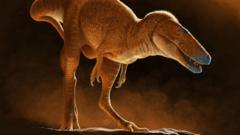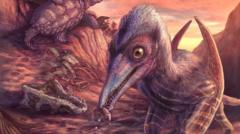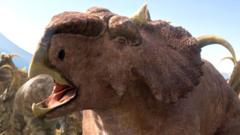Researchers have identified a new species of dinosaur, Khankhuuluu mongoliensis, which provides critical insights into the family tree of tyrannosaurs, including the famous T.rex, shedding light on how they evolved into formidable predators.
A Newly Discovered Dinosaur Species Reshapes Tyrannosaur Evolution

A Newly Discovered Dinosaur Species Reshapes Tyrannosaur Evolution
Research unveils Khankhuuluu mongoliensis, a pivotal tyrannosaur ancestor, changing our understanding of dinosaur evolution.
The recent discovery of a new dinosaur species from a Mongolian museum has startling implications for our understanding of tyrannosaur evolution. Named Khankhuuluu mongoliensis—meaning "Dragon Prince of Mongolia"—this dinosaur is now recognized as the closest known ancestor to all tyrannosaurs, reshaping the evolutionary narrative around these iconic predators.
Scholars published their findings in the esteemed journal Nature, detailing how the two 86 million-year-old skeletons belong to this previously unrecognized species. Palaeontologist Professor Darla Zelenitsky from the University of Calgary explained that the term 'Prince' symbolizes its status as an early and relatively smaller tyrannosauroid compared to its massive descendants like T.rex.
Initially, tyrannosauroids were small, agile hunters, with this species marking a significant evolutionary transition toward the larger, more terrifying giants that ruled North America and Asia until the extinction event that wiped out the dinosaurs. The estimated weight of Khankhuuluu is around 750 kg, a stark contrast to the eight times heavier adult T.rex.
"This fossil serves as a transitional piece that helps us understand the complexities of the tyrannosaur family tree," noted Professor Zelenitsky. The discovery also highlights early features critical for the eventual overwhelming strength of the tyrannosaurs, such as specialized skull anatomy designed for powerful bites.
Researchers Jared Voris, who led the study, mentioned that examining the nasal bone reveals adaptations that gave rise to the potent biting force characteristics of later tyrannosaurs. Such evolutionary traits enabled T.rex to pursue larger prey and even consume bones.
The skeletal remains were first unearthed in Mongolia during the 1970s and misclassified as related to Alectrosaurus. However, Voris’ keen observations identified its unique tyrannosaur-like characteristics and culminated in the new classification. This remarkable evolutionary development illustrates how the movement of dinosaurs between North America and Asia, facilitated by ancient land bridges, propelled the diversification of the tyrannosaur lineage.
"In essence, before tyrannosaurs rose to their dominion, they were once mere princes," emphasized Professor Zelenitsky. This finding not only illuminates the evolutionary journey of these magnificent creatures but also serves as a testament to the ever-evolving nature of science and our understanding of prehistoric life.
Scholars published their findings in the esteemed journal Nature, detailing how the two 86 million-year-old skeletons belong to this previously unrecognized species. Palaeontologist Professor Darla Zelenitsky from the University of Calgary explained that the term 'Prince' symbolizes its status as an early and relatively smaller tyrannosauroid compared to its massive descendants like T.rex.
Initially, tyrannosauroids were small, agile hunters, with this species marking a significant evolutionary transition toward the larger, more terrifying giants that ruled North America and Asia until the extinction event that wiped out the dinosaurs. The estimated weight of Khankhuuluu is around 750 kg, a stark contrast to the eight times heavier adult T.rex.
"This fossil serves as a transitional piece that helps us understand the complexities of the tyrannosaur family tree," noted Professor Zelenitsky. The discovery also highlights early features critical for the eventual overwhelming strength of the tyrannosaurs, such as specialized skull anatomy designed for powerful bites.
Researchers Jared Voris, who led the study, mentioned that examining the nasal bone reveals adaptations that gave rise to the potent biting force characteristics of later tyrannosaurs. Such evolutionary traits enabled T.rex to pursue larger prey and even consume bones.
The skeletal remains were first unearthed in Mongolia during the 1970s and misclassified as related to Alectrosaurus. However, Voris’ keen observations identified its unique tyrannosaur-like characteristics and culminated in the new classification. This remarkable evolutionary development illustrates how the movement of dinosaurs between North America and Asia, facilitated by ancient land bridges, propelled the diversification of the tyrannosaur lineage.
"In essence, before tyrannosaurs rose to their dominion, they were once mere princes," emphasized Professor Zelenitsky. This finding not only illuminates the evolutionary journey of these magnificent creatures but also serves as a testament to the ever-evolving nature of science and our understanding of prehistoric life.










